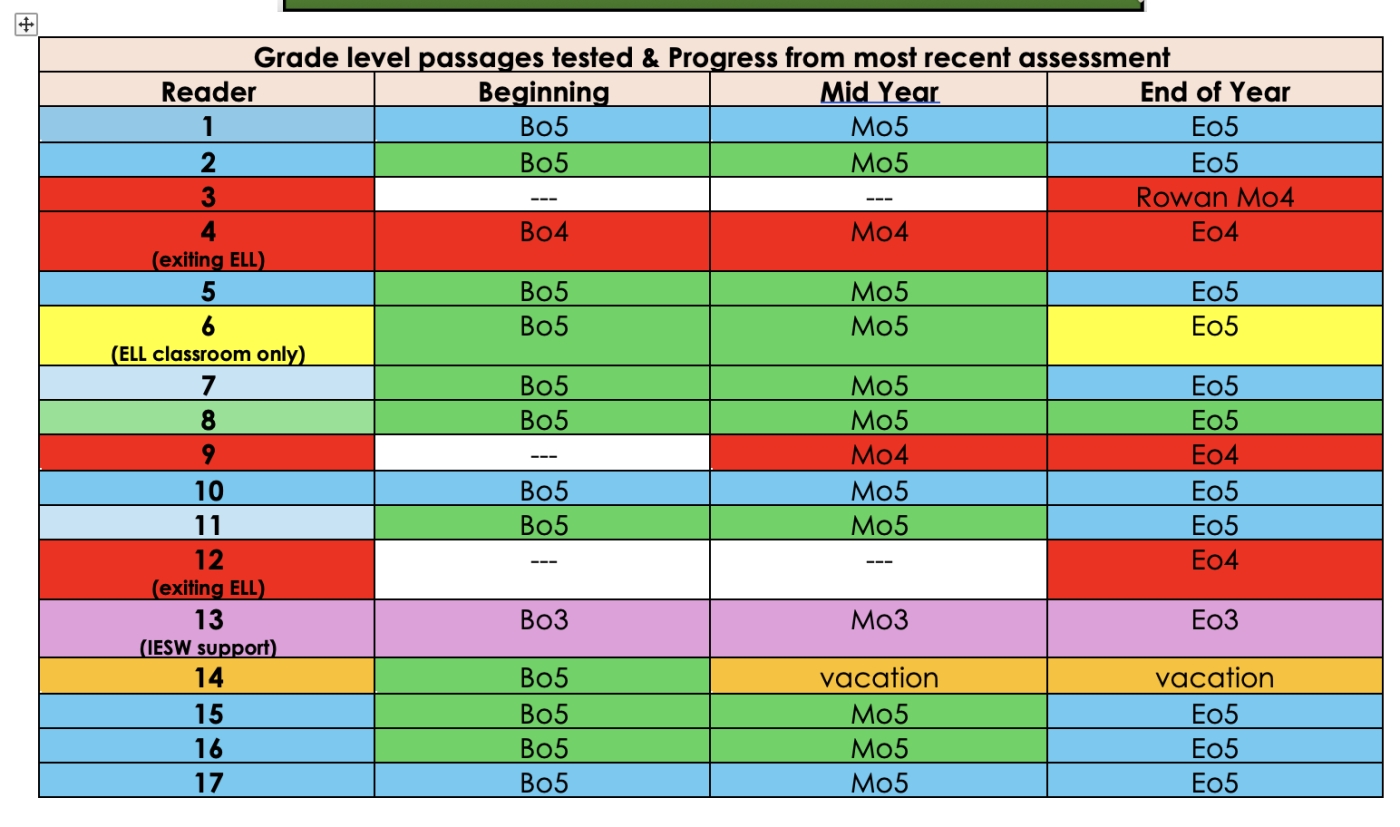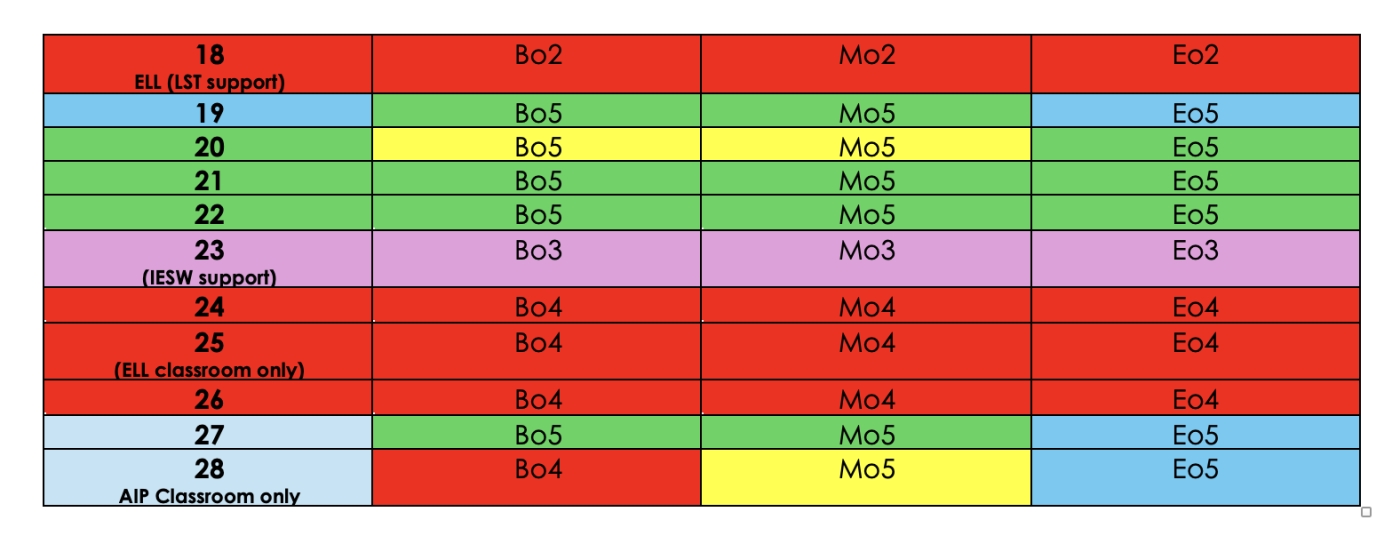Ecole Woodward Hill 24-25
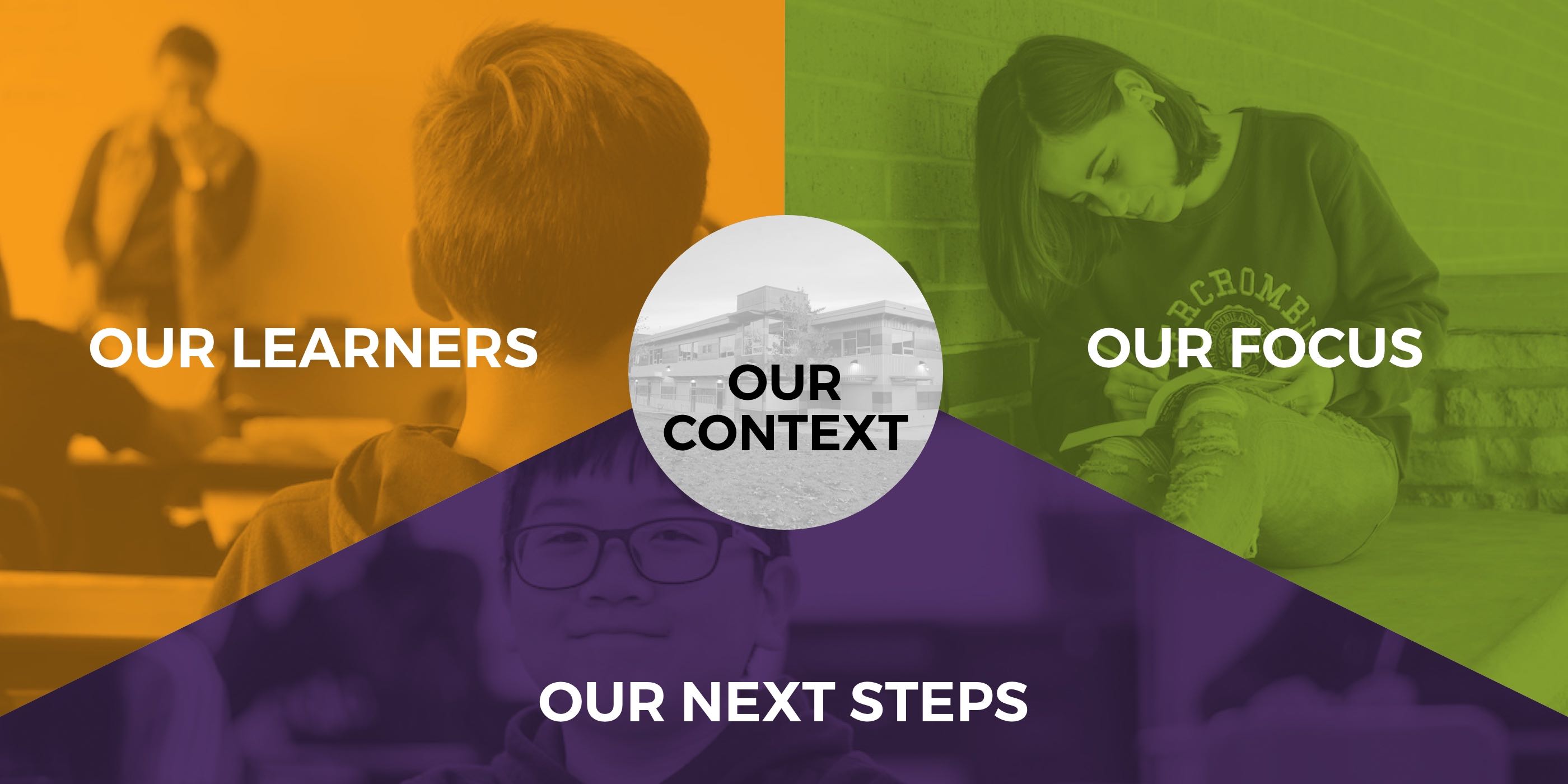

OUR CONTEXT
OUR LEARNERS
OUR LEARNERS
Reading is a foundational skill that opens a world of opportunities for our students. Where our youngest learners are building skills to learn how to read, our intermediate students continue to develop their reading reading skills to broaden their understanding of literature, science, sociology, technology and many other concepts.
Our learners use decoding strategies to strengthen their reading skills.
Our youngest learners practice decoding strategies to develop strong reading skills. The image on the left demonstrates using picture clues to build meaning. Using picture clues is an important beginning reading strategy for all learners, as Sumair describes, "I knew this word was 'robot' because on the left page it kind of looks like a robot. Also, I read this book a lot. Also, the first letter is'r' and that makes sense."
In the middle image, students receive direct instruction on how to use Magic 'e' to decode and write words. Direct reading instruction is central to helping students learn how to read at all levels. In the example below, the use of white boards during whole group instruction is not only fun for students, but also provides instant feedback to the teacher on student understanding. The third image on the right demonstrates how students use loose parts to create stories. Through story writing, students develop language skills that support their reading development.

The videos below demonstrate reading strategies used by our early learners. Encourage your children to practice these strategies while reading at home.
Blend the sounds
Chunking
Magic "e"
Flip the Sound
Two Vowel Rule
Use Picture Clues
Our learners develop their vocabulary skills to be strong readers.
Our learners are exposed to rich vocabulary through non-fiction resources, field trip, pictures, videos, assemblies and classroom discussion and activities. By intentionally exposing our learners to language, they are developing competency in reading skills.
Our learners can recognize and value the joy in reading.
Our learners have access to rich resources and high interest books to nurture joy in reading. Finding joy in reading supports feelings of calm and self-regulation. Our Library Learning Commons is a hub in our school and serves as a space where students can nestle with a good book, find their next great read, and explore alternative genres to pique their interests. So, while learning to read is a priority for our learners, it is equally important to find joy in literature.
Reading is joyfully calming
Sia reminds us that, "you can calm your body by reading a book standing up, sitting down or lying in your bed. It's good to do when the room is quiet."
There is joy to be found in sharing a book
Buddy Reading is one way books can be enjoyed together.

Discovering the right book or genre brings joy to our lives!
Our librarians are the perfect people to help students to find books and genres of interest. Beth and Jayde talk about joy in reading.
Our learners support each others' reading skills through mentorship and practice (and have fun while doing so!)
Reading Buddies is a school project where older students read with younger learners. Reading Buddies provides opportunities for mentorship, relationship, community building, and reading support. A win, win, win!
OUR FOCUS
OUR FOCUS
Reading proficiently is a foundational skill that enriches the well-being of our students now and in the future. Strong readers have the opportunity to better their lives both professionally and personally. Our team of educators understand the significance of developing our learners' reading skills. Each day our learners experience text-rich environments and explicit reading instruction to support the development of their full potential. Our vision is to have all students reading strategically and with joy.
Our students' learning goals are:
- valuing the joy in reading and its contribution to feeling calm
- reading strategically
- developing strong vocabulary
While we have assessed all learners' reading skills, we have focused on our early learners - Kindergarten to Grade 3 - to document and identify successes and gaps.
Reading
Reading spans all areas of learning from arts and culture to science and technology and beyond. And because reading to learn is central to our students' school experience and life opportunities, our educators prioritize learning to read for all children. A quote by one of our learners aptly describes learning to read, "reading to someone helps me to be a better reader because when you’re learning the words you can help people”.

OUR NEXT STEPS
Goal 1: Reading Reflections: Valuing the joy in reading and its contribution to feeling calm
We are a high energy class, and choice reading became a reliable strategy to gain or return to a sense of calm ahead of focused learning. We explored choice reading as an option during morning Soft Start, in Quiet Reading after lunch, and as an option for a short independent “Brain Break”.
We started the year with a typical mix of readers. We had reader profiles including
- highly engaged readers with favourite genres and authors
- reluctant readers who felt challenged to self-select titles for meaningful bursts of choice reading
- readers who were sometimes indifferent and inconsistently engaged during choice reading.
To make the most of choice reading as a self-regulation strategy, we needed to develop capacities in two key areas. We fostered an environment where we consider genres and authors, talk about thematic preferences and dislikes. This helped facilitate more mindful selections of texts where book choices could better reflect identity, interests, favourite genres, authors and feel relevant.
We also needed to develop awareness of the emotion and body cues that help us make decisions relating to the impact of the classroom environment on our reading. We make mindful decisions about
- locations (lighting, neighbours, flexible nook spaces, egg chair, pillows…)
- supplemental tools (headphones, water, snacks, fidget tools)
Readers recently reflected on their experiences using choice reading as a strategy to develop a sense of calm. Their reflections follow.
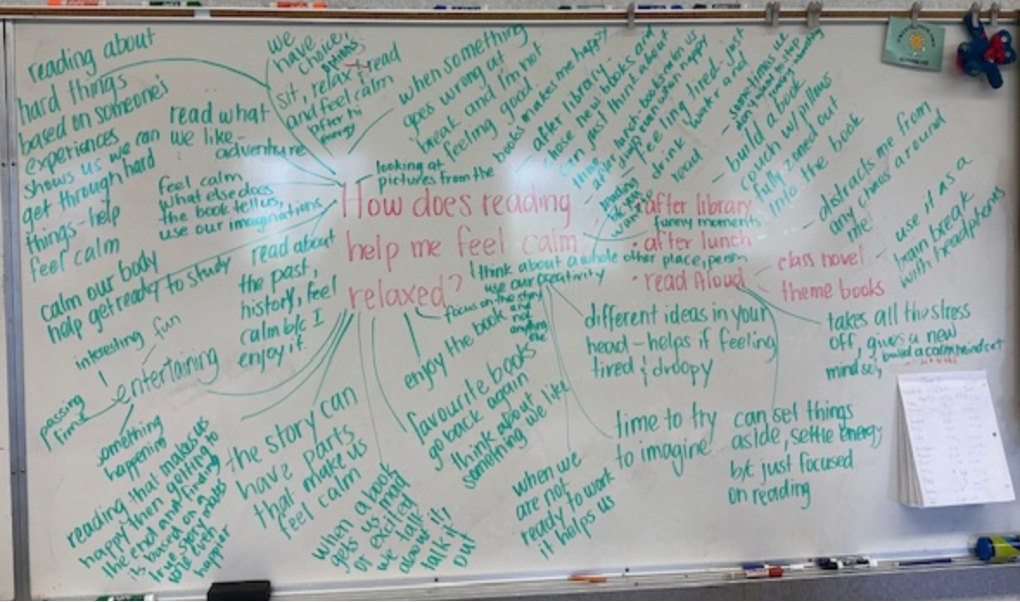
We focused on developing capacities as readers in a range of ways. We started the year with a typical mix of readers with profiles including:
- highly engaged readers, with favourite genres and authors, who choose to read in free time
- readers who were out of the practice of efficiently selecting preferred books (endless book shopping during choice reading time)
- reluctant readers, those who experienced challenges to decode and comprehend text, who found it difficult to self-select titles that met their needs and maintained their dignity
- somewhat indifferent readers who were inconsistently engaged when reading
Then & Now
Readers recently shared what they find enjoyable about reading. They considered the opportunities for reading across they day, their preferences and dislikes. The selected reflections shared below represent readers who started the year stuck in a negative reading mindset in some way. Characteristics of that early year mindset are noted with their recent reflections.
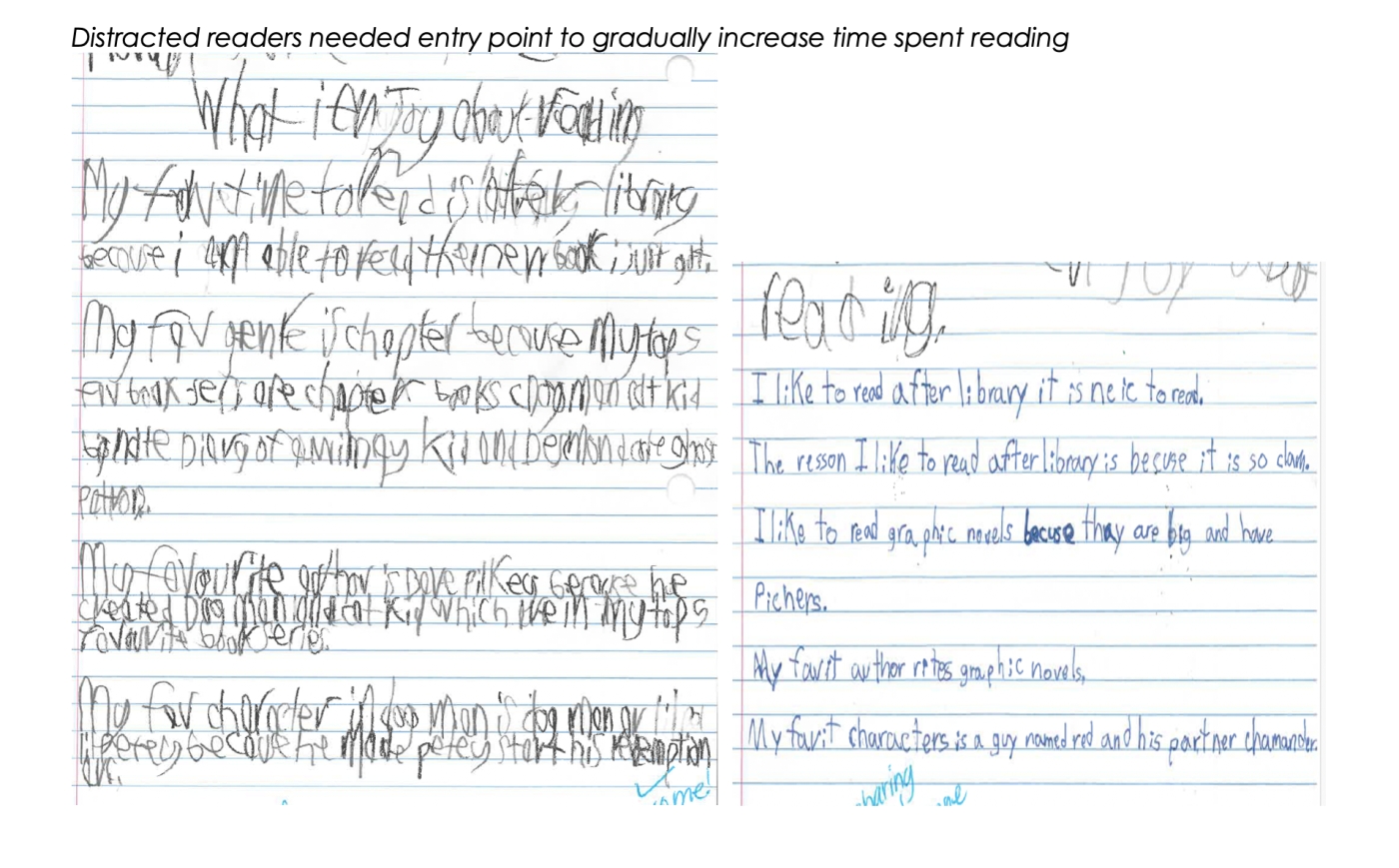
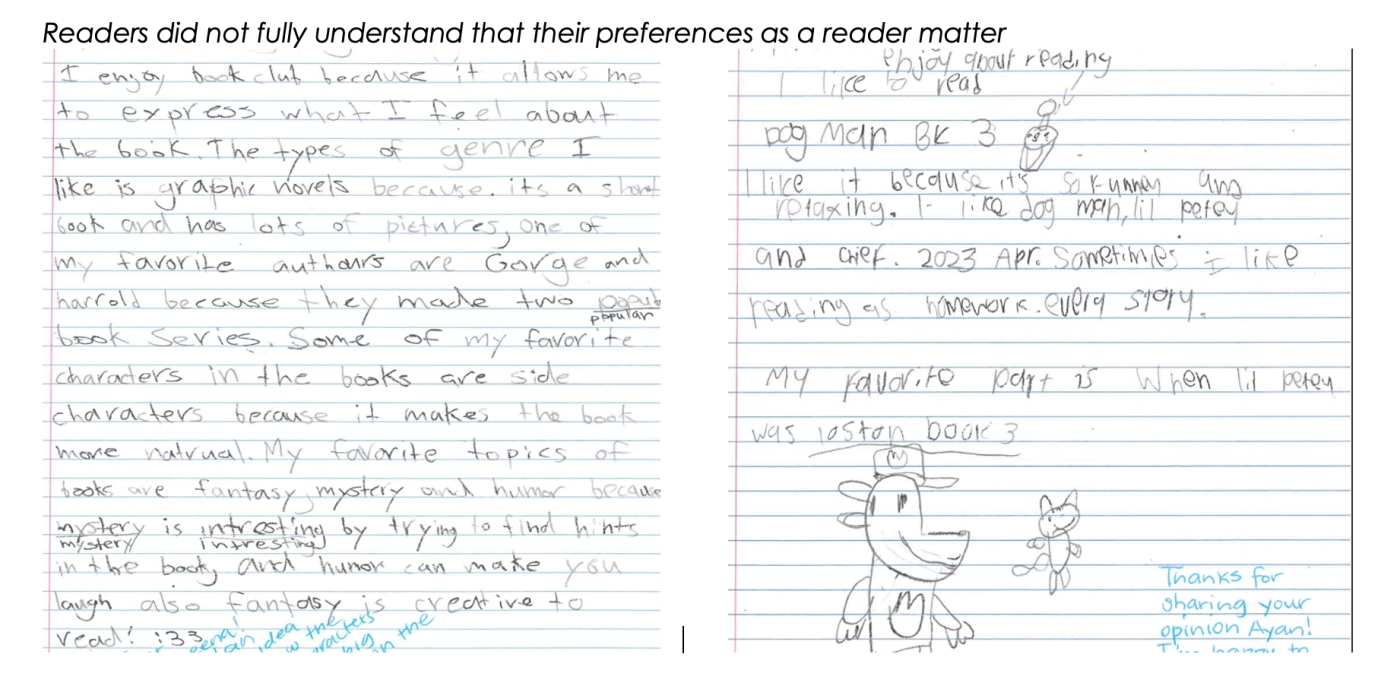

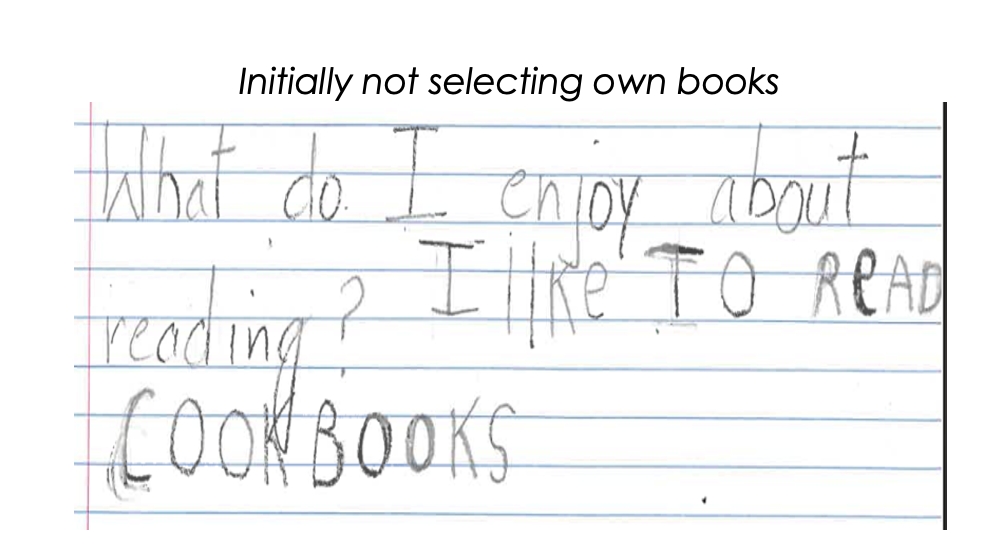
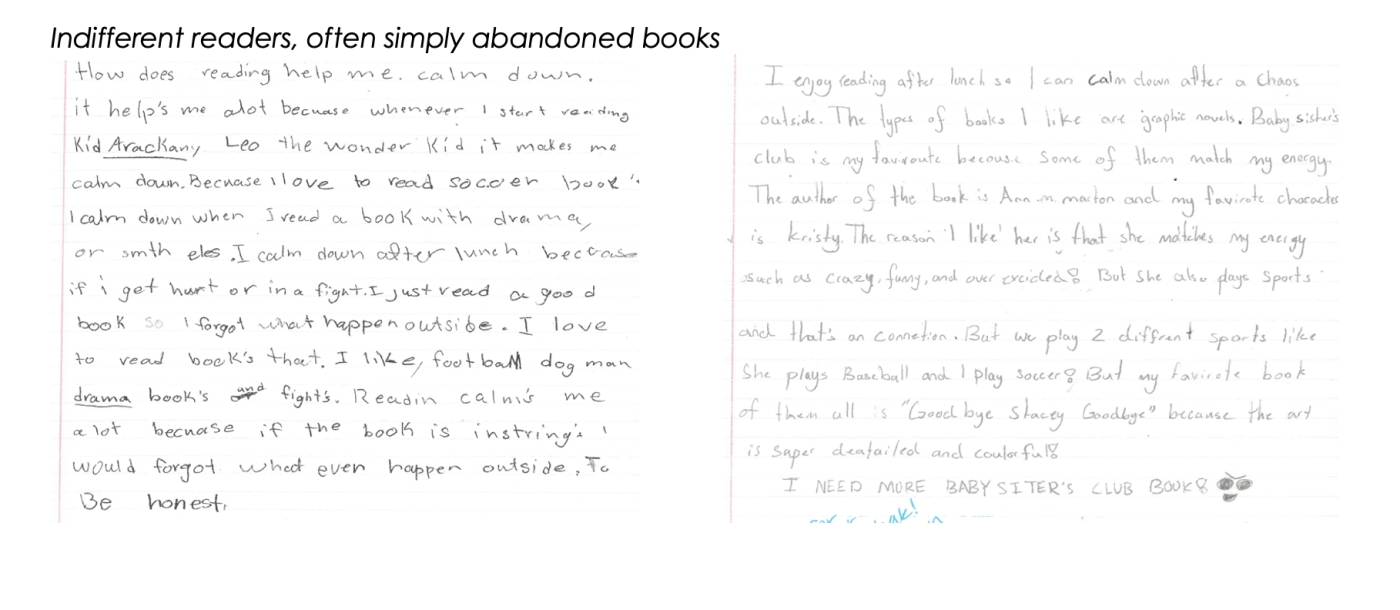 Goal 2: Reading Strategies: We Read Strategically
Goal 2: Reading Strategies: We Read Strategically
Readers developed capacity to read strategically using a variety of thinking routines across contexts. 3Cs – My Cares, Connections and Concerns and Book, Head & Heart encourage readers to attend to important aspects of a fiction text while elevating their reader identity and interests. Notice & Wonder supports close reading of information texts while also highlighting the role of reader identity and interests in comprehension. All three routines build engagement and motivation by centering text relevance as readers consider what is important to them within a text that may or may not be self-selected. Reader voice is strengthened through the routines’ emphasis on sharing an opinion paired with reasons and specific text examples.
Given readers’ varied experiences in responding to text through open-ended thinking routines, we followed a gradual release model over the year
- initial explorations of 3Cs and BHH during Shared Reading of picture books; Notice & Wonder during Science and Social Studies reading
- Coached Practice introduced during focus on self-selected picture books on a shared theme
- final phases of Coached and Independent Practice took place through 3 cycles of Book Clubs, Science and Socials micro inquiries
- we concluded with reader-selection of 3Cs (care, connect, concern) or BHH (book, head, heart) to respond to self-selected picture books on shared themes
Early experiences with the routines showed areas where Shared Reading and Coached Practice would focus. We needed to address
- surface level comprehension
- stamina and sustained focus during periods of extended reading
- ‘gathering’ pieces of information from the focus text that are disconnected from goals
- skipping words, phrases or passages initially not decoded or recognized
- sharing opinions without reasons from the text
To address those areas, mini-lessons focused on
- reading with a clear purpose in mind (thinking routine focus and Author’s Purpose)
- determining what is important to readers interests and identity (3Cs and BHH)
- establishing the Author’s Purpose, supporting with text evidence
- making thinking visible (post-its, graphic organizers)
Graphic organizers show reader’s then and now growth over time – fall, mid-year and late spring.
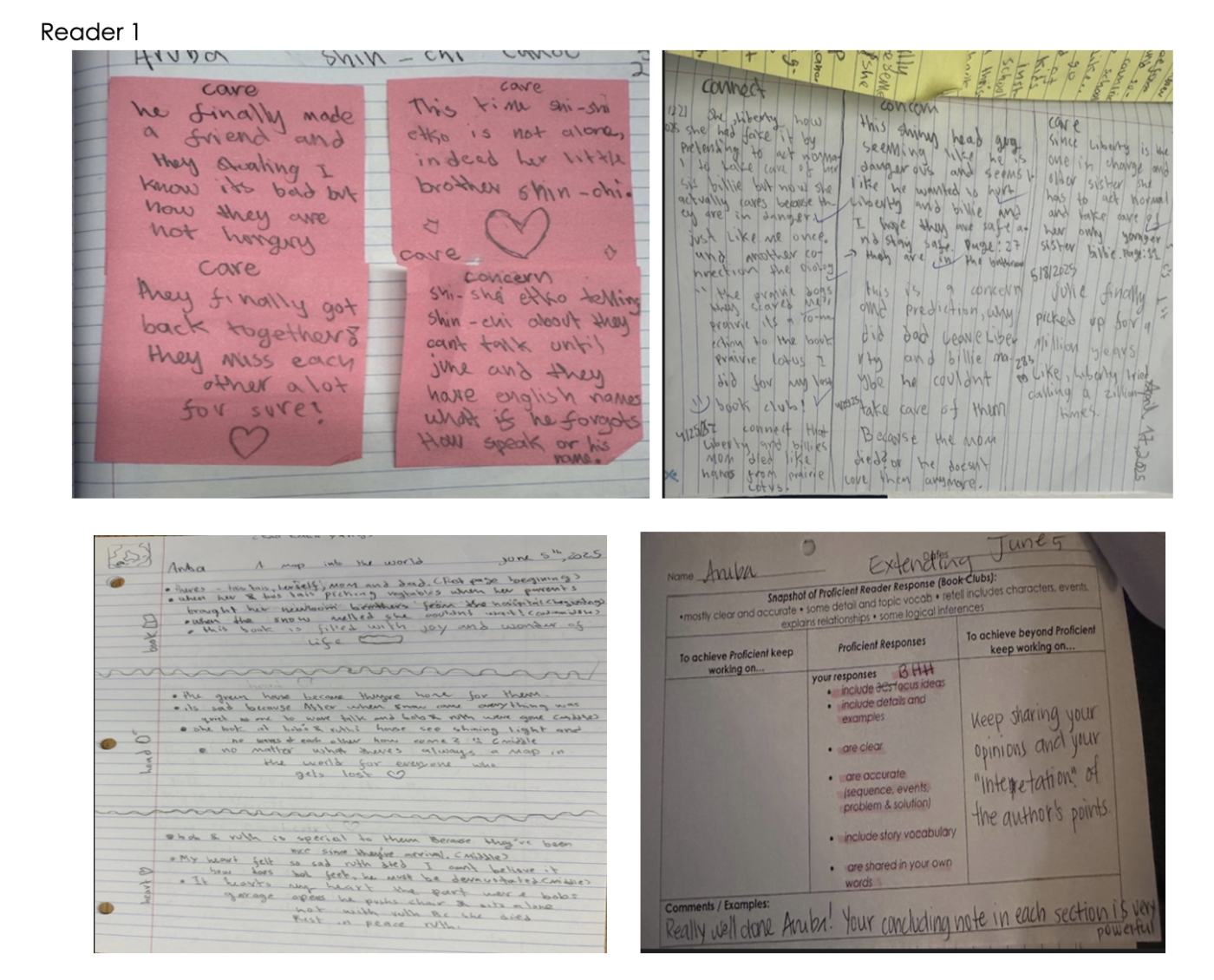
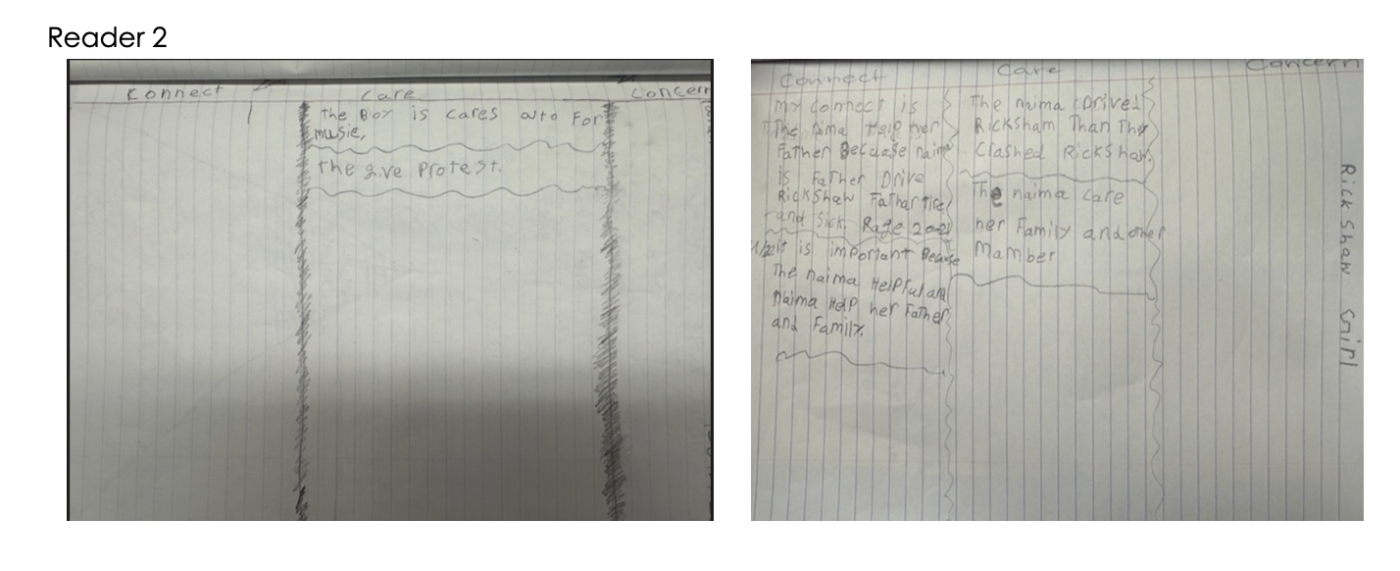
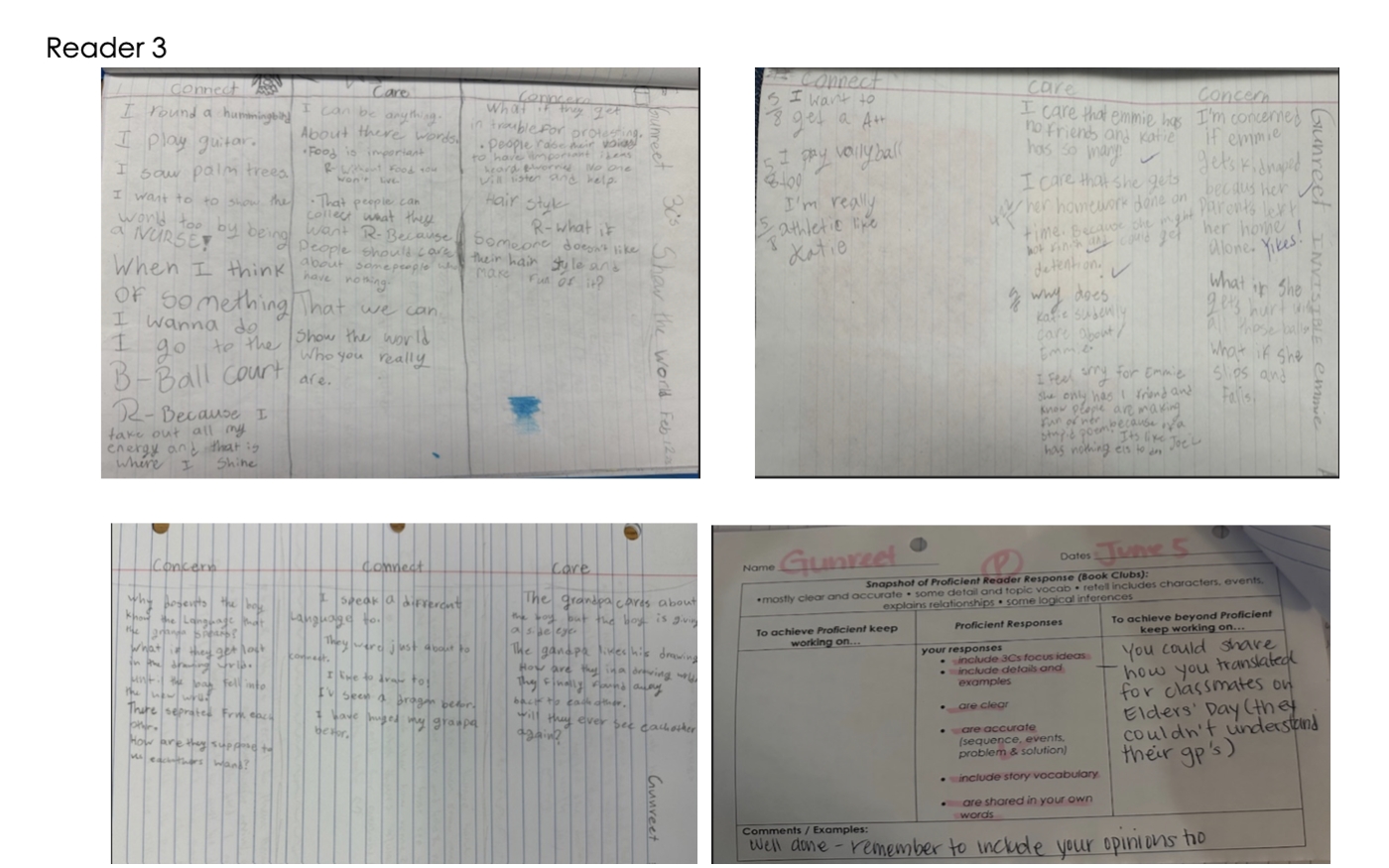
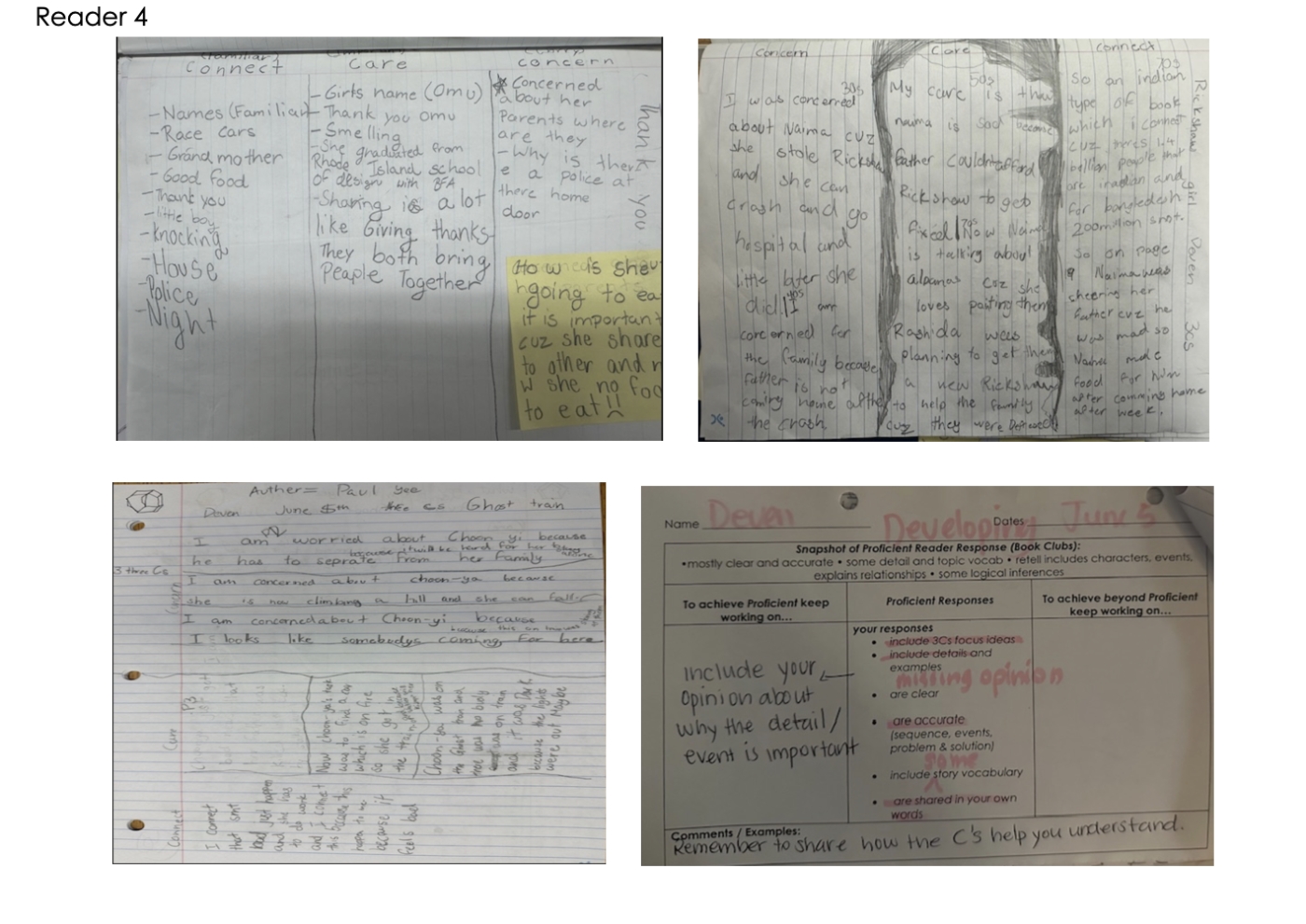
Goal 3: Exploring Vocabulary through Reading Fluency
Strong vocabulary has an impact on overall reading comprehension and fluency (prosody, rate and accuracy). Readers with strong vocabulary generally take less time decoding, as they utilize a broader bank of words that are read and understood automatically. The cognitive load shifts from decoding to comprehension.
Throughout the course of the year readers developed vocabulary across reading contexts. To develop readers’ vocabulary, isolated word study routines included:
- exploration of roots and affixes in selected content area vocabulary
- Frayer model routine for selected Tier 2 (high-utility academic words) and content area vocabulary
- thinking routines used during partner and small group structured fluency work, and whole class Read Alouds
Assessment results show that for a year’s learning, a year of gains were made for all but one reader. For those that made a year’s gain, 11 readers showed stronger results as they shifted one or more categories away from risk to more negligible risk.
For the purpose of sharing, students reading below grade level, except for 2 readers with full times IESW support) are listed here in Red. While each of them made a year’s worth of growth, (maintained reading at that grade level, did not back slide) they are still not at grade level.

